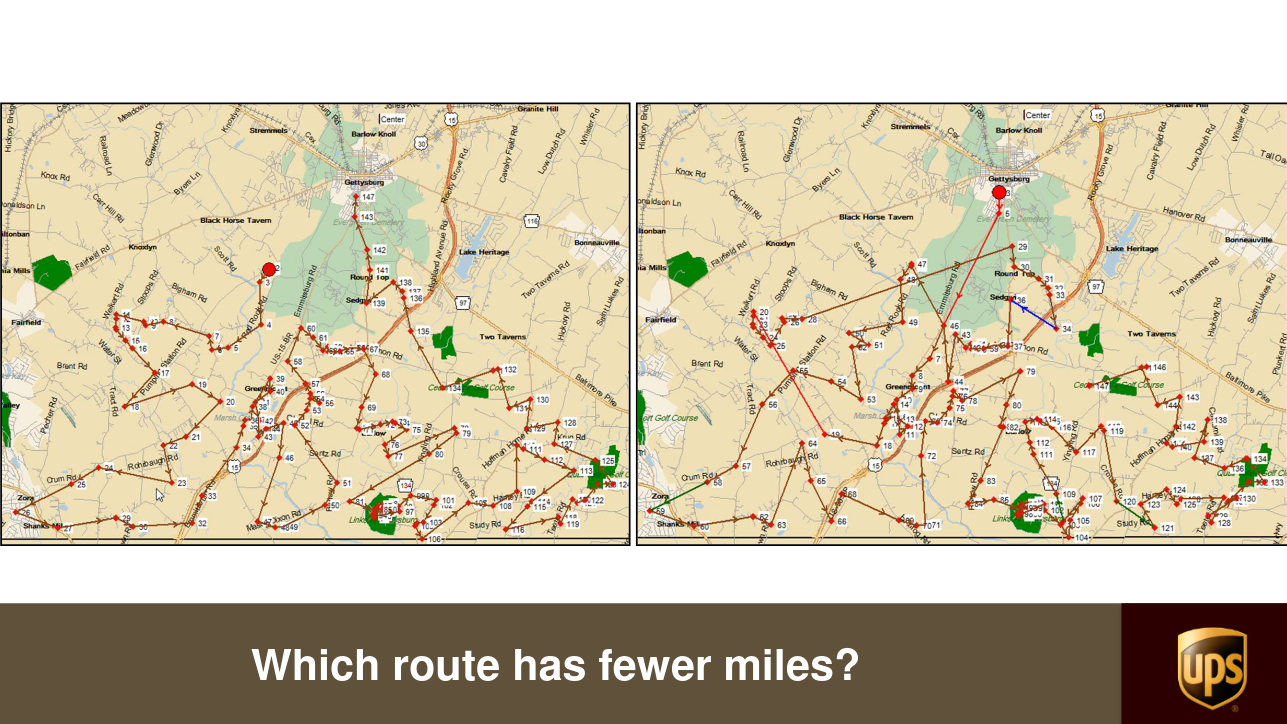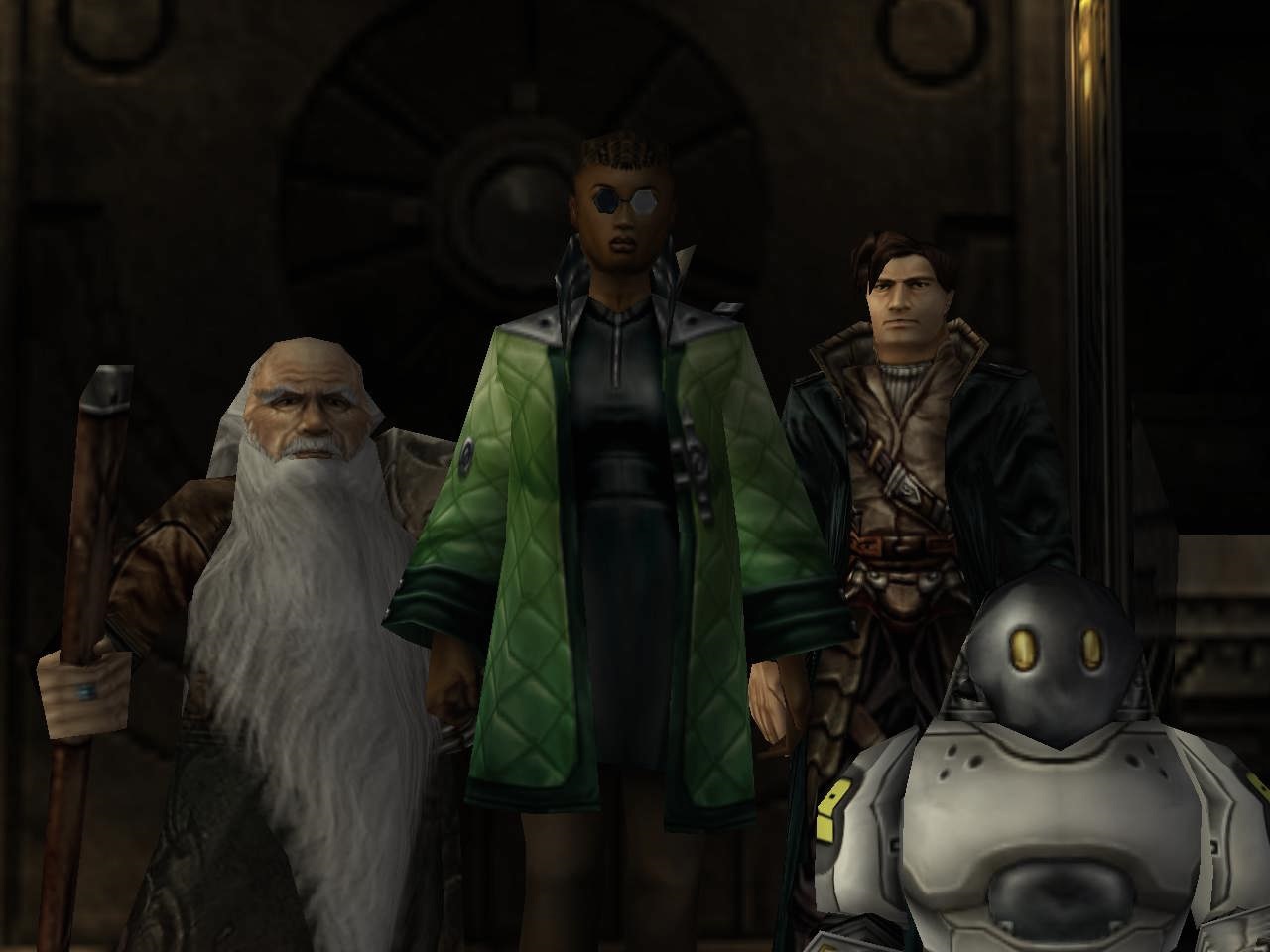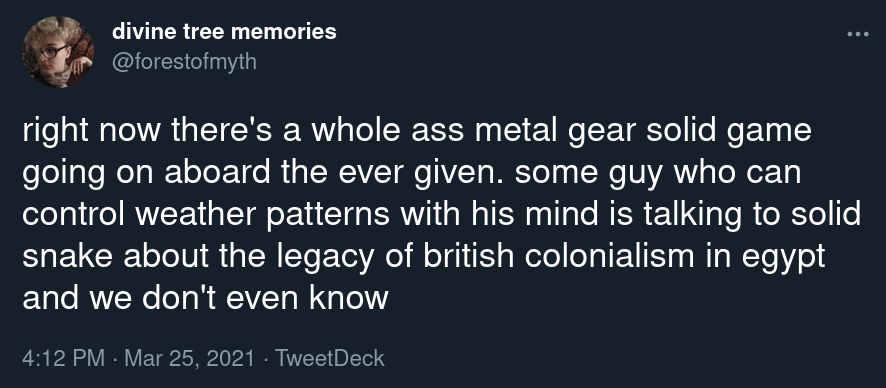Log: 3/26/2021
This week: fugues, the US’s vulnerable infrastructure, CAD software, routing algorithms, Miyazaki and Marxism, Anachronox, and a few other things.
Fugues
Growing up my only exposure the musical composition form of the “fugue” was through Bach, so I mostly only ever heard in his very baroque style (for example, Toccata and Fugue in D minor, which I probably first encountered in the game Dark Castle). But the form as defined is pretty open-ended: it’s mostly about having one theme (melody) that is played somewhat independently by different voices in counterpoint. Shostakovich’s Fugue in A Major is a nice example of how different fugues can sound. This video on fugues in (or rather, their absence in) film scores helped me further think about fugues beyond Bach’s sound.
I also came across this old essay on fugues in the New York Times, “A Gorgeous Tapestry Woven as You Listen: The Art of Fugue”, that describes almost exactly how I’m thinking about fugues in relationship to the new game I’m working on (and summarizes the form well):
The fugue now seems a strange musical form: with its imitating and intertwining voices it embodies the tastes of an antique era. For the last two centuries we have been preoccupied elsewhere. Much concert music has been thought of as having two ingredients: a melody and an accompaniment. The melody is the solo voice: the instrumentalist or the singer expressing emotion, demanding attention. The accompaniment is the background, emphasizing a melody’s tensions or commenting upon them, embracing a voice or confronting it. But melody reigns supreme. When we praise music, we are often praising its melody. Even symphonies, with their hundred instruments, are often remembered mainly through their themes.
The fugue is an entirely different story. It is all melody, or, perhaps, all accompaniment. It does not have an individual voice; it has many individual voices. And each voice is an image of the others, accompanying them by echoing them. A fugal theme may not even be distinctive as a melody. It might seem awkward, incomplete, lacking resolution or purpose.
But set that theme in motion. Then, after a few measures, set another voice to work, singing the same theme, perhaps at a different pitch; then a third, or a fourth, or a fifth. Build tension as these voices echo each other in cascades of fresh entrances; release tension as they break into free-form episodes. Invert a voice so it moves up where it once went down and down where it once went up. Fracture the theme or expand it. Keep the separate voices in a state of nearly perpetual motion and then confound the ear by allowing them to intertwine.
Such is the fugue – a drama not about the individual voice at large in a society of sound, but a drama about a society of sound created by related individual voices. It is an astonishing structure, constructed with intense concentration. In the midst of that musical society, combinations can never be random or arbitrary. Rules govern these interactions. And the character of the theme helps determine the character of the fugue itself.
…Each fugue’s theme has a distinctive character; each character constructs its own society; and each society is bound by law while allowing extraordinary liberty. The fugue is a model of an ideal society in which obligation and independence coexist, in which the individual is incomplete without the society and the society unthinkable without the individual, in which passion erupts but reason rules.
There’s also this piece, “Can a Novel Be a Fugue?”, that points out the etymology of the term:
The word fugue comes from the Latin fugo, “flight,” as well as fugere, “to flee” (as do the words fugitive and refugee).
Finally, this piece, “Law is a Fugue”, has a perspective on “fugue-as-subjectivity” that I hadn’t considered:
This leads me to draw out a first line of thought from the metaphor: the comparison of the fugal subject with the human subject.
…For [Julia] Kristeva (as for many others), the subject “I” is an unstable identity. It is in continuous flux, under constant tension, and in the process of being made. The subject subsists in what she calls an “open system” where the structure of the subject is open to other structures that permit the subject to permanently renew itself. This open system could also be seen in terms of a more radical thinking of community. For example, J-L Nancy has written in similar vein but different discursive register of “inoperativity” or being “unworked”. For Nancy, the inoperative community is an ontology of community independent of any striving towards artificial delineation, cultivation, or hypostatization. The essence of community is that which is in a state of constant tension and flux between inside and outside, between finitude and infinitude, between subjects with others.
It strikes me that the subject of the fugue mirrors this thinking very well: the fugal subject is itself in a state of flux, in the process of being iterated yet still identifiable (as if an ‘I’) through the whole piece. Moreover, its identity is challenged and modified by the multiple voicings harmonising in counterpoint. One could call such polyphonic counterpoint the open system of voicings or even the community of voicings. Both human and fugal subjects become or modulate into something other when with voices in community, all while retaining their identities. Both are subjects in process.
There’s also this interesting tidbit, connecting things back to fugues-that-break-with-Bach:
There is a flux or “play” between the fixed canonical subject and the breaking of the canon that subverts the rules that first constituted it, an act of sublime beauty in self-sabotage. … The late Baroque music theorist, Jean Phillipe Rameau, wrote that fugal art “cannot be reduced to rules” and that it is as much about defying rules as it is to follow principles. 3 Some say J S Bach, undeniably the greatest exponent of the fugue, should be avoided if you want to learn the “true” principles of the fugue. He was brilliant precisely because he broke the rules.
I found those last two while searching for an image for this post, kind of funny how that happens.
America’s Drinking Water Is Surprisingly Easy to Poison, Peter Elkind & Jack Gillum.
A pretty worrying look into the cybersecurity vulnerabilities of US water treatment systems.
So many of these problems go back to default passwords as a major attack vector. I wonder a) what % of attacks this actually account for (since there are so many other failure points that are mentioned in that piece, e.g. non-default passwords but the same password everywhere and widely shared), and b) is there no better approach to creating initial passwords for devices?
The deeper problem is, maybe unsurprisingly, a drive towards lowering costs (mostly through eliminating labor costs) because this kind of critical infrastructure is so cash-strapped:
The origins of the problem are clear. The vast majority of the nation’s water systems are small and publicly owned, with limited resources and aging infrastructure. As they turned to digital systems and monitors to boost efficiency while saving money and staff, they failed to install the safeguards and carry out employee training needed to secure the resulting vulnerabilities. “Every one of them had one guiding principle over the last 50 years: increased automation to lower the size of the workforce to keep costs down,” Montgomery said. “Along with that, there should have been an investment in the cybersecurity of the infrastructure. But that did not happen.”
I wonder what the cost savings are after the necessary cybersecurity measures are taken into account?
There have definitely been more stories of these kind of industrial/infrastructural cyber-attacks, but I feel like they must still be vastly underreported (for example, hospital ransomware attacks feel like part of everyday background noise now). And will probably only get worse and worse as the trend outlined in the quote above continues.
This also reminds me of a data catalog I came across recently, the Homeland Infrastructure Foundation-Level Data, which has a surprising amount of geospatial data available on US infrastructure (power transmission lines, hospitals, power generation facilities, etc) which are provided for researchers to assess the country’s preparedness against these kinds of attacks.
h/t Kira
SolidPython
Recently I started using OpenSCAD for sketching out simple woodworking projects and sewing patterns. There are a lot of options for CAD software, many more powerful than OpenSCAD, but I like that you control OpenSCAD through code. For me that’s a lot easier than using a mouse or forms to layout a project. There are no doubt limits–I’m guessing that as designs get more sophisticated, the advantages of sketching the object out in code decline. But so far it’s worked well.
The only thing is that the OpenSCAD language is kind of clunky. Even modest projects can feel overgrown and difficult to manage. I came across SolidPython, which is basically a Python library that compiles to OpenSCAD–you can leverage the power of Python and have a bit of a cleaner interface. For example, this bill of materials decorator looks amazing:
Put
@bom_part()before any method that defines a part, then callbill_of_materials()after the program is run, and all parts will be counted, priced and reported.
Here’s a compost bin I designed in OpenSCAD:

ORION: The algorithm proving that left isn’t right

ORION is the route-planning system that UPS drivers use. Interesting to read their comments on the r/UPS subreddit. Every comment I’ve seen mention ORION is about how nonsensical (to a human) the routes are, it slows them down, doesn’t compare to experience drivers’ route knowledge, etc. The shortcoming might be ORION itself, or, as this comment suggests it might be the fault of the dispatcher entering in inaccurate data, or it’s just because there are so many factors like specific pickup/delivery times that rule out more efficient and human-legible routes. The routes are puzzling even to outside observers waiting for their packages.
My main interest in ORION is because of dial-a-ride systems; I first learned of them after reading this book, Multi-agent System Applications: On-demand Electric Vehicles Dial-a-Ride Operation System. Dial-a-ride systems are basically a public precursor to Uber and the like (but with minibuses instead of personal vehicles), from as early as the 1970s. You call up the service a day in advance and let them know when you’d like to be picked up and where you’re going. Then some route planner or route planning algorithm figures out routes for each available bus. It’s been some time since I read about them in detail, but if I recall one major challenge was limitations in route planning algorithms. Nowadays computing power is not only cheaper but the algorithms have been improved with these ride-sharing services. UberPOOL and Lyft Line basically “reinvented” dial-a-ride systems. Interest in the topic is up again with the possibility of autonomous vehicles, but there still seems to be a lot of promise in their public transit application, and taking whatever Uber or Lyft have developed for that purpose is nice example of feasible algorithmic expropriation.
More on these “demand-responsive transit” systems
Miyazaki’s Marxism, Zeria
@[Miyazaki’s Marxism, Zeria](https://www.youtube.com/embed/UMXN6B-tqZM)
There is so much good media analysis on YouTube and this one is a great reflection on Miyazaki’s trajectory from Marxism–especially his belief in labor’s power to change the world–to a disenchantment of industrial progress in general and a skepticism towards any possibility of revolutionary change. The more explicitly Marxist elements fade and earlier elements that once co-existed with those previous beliefs come to the fore: romanticism of agrarianism and a more ecologically-harmonious pre-industrial past. Eventually, this romanticism gives way to a deep pessimism and misanthropy in the Nausicaä manga (which sounds wild), where ecological collapse takes center stage. Humanity is irredeemable.
This gives way to Princess Mononoke and Spirited Away, which start to synthesize all of these phases and point towards the possibility of something more positive.
Miyazaki’s fluctuating relationship with Japan and nationalism also runs throughout his films. The scale of Japanese atrocities during World War II does not strike me as well known in the US, but I know of them through my family; my grandfather refused to buy Japanese-made cars since several Japanese car companies (Mitsubishi, as in Miyazaki’s The Wind Also Rises, and Subaru) have their roots in creating the aircraft used in the war. Miyazaki had a close connection to the war: his father owned an airplane factory during WWII. He clearly struggled with this and Japan’s history, and is definitely not trying to make excuses for that history, but I have to say that whole aspect of his work makes me uncomfortable. Especially because of how Japan’s reputation in the West has been so sanitized through anime and that network of cultural products.
Also mentioned in the review, but could probably be expanded upon a lot, is Miyazaki’s own changing class position throughout his career and what influence that had on his movie’s themes.
Anyways, there’s a lot more in the review–definitely worth a watch!
Anachronox
Anachronox is a great game (now 20 years old!) that isn’t very well-known, especially compared to the JRPG lineage (Final Fantasy and Chrono Trigger) it draws a lot of inspiration from. I re-watched Errant Signal’s reflection on the game which reminded me a lot of the game’s best aspects: a strong ensemble cast (each of whom had a special skill for interacting with the game world), its non-seriousness/lightheartedness/comedy, its range of rich environments, and its willingness to try a lot of things–for example, a literal planet as a party member and a comic-book themed sequence that breaks from the rest of the game’s style.
The various planets in the game’s universe give a nice sense of the game’s humor (quoting the video):
- Democratus: a planet which, as the name implies, enshrines democracy as its core value, but “reveal[s] itself to be an oligarchy because voting on issues is hard and the everyday person might not get it”
- Sunder: “a planet full of scientists that ironically acts more like a religion by sequestering heretics whose scientific views goes against the orthodoxy”
- Hephaestus: “a religious planet that operates more like a hyper-capitalist theme park/industrial mine where bishops hawk t-shirts”
The game was originally supposed to have a sequel, because it was basically a financial failure, it never happened.
Short links
Make it rain: US states embrace ‘cloud seeding’ to try to conquer drought, Oliver Milman
First I’ve seen of cloud seeding in the US. I remember hearing about it while living in China. I’m guessing it also has some drought/agricultural purpose but I was told that it was to help clear out pollution (the skies were noticeably cleaner after rainfall). Another example of “solving” the problem but not the cause: “Experts who have studied cloud seeding point out that it is no panacea, given it doesn’t solve the systemic causes of drought”.
Thieves Nationwide Are Slithering Under Cars, Swiping Catalytic Converters
Thefts of catalytic converters are increasing as the prices of palladium and rhodium reach record highs, driven in part by stricter pollution regulations for cars. It’s an interesting example of how material substitution just throws similar problems down the line. Palladium replaced platinum in catalytic converters as platinum’s price climbed, and then there was talk of switching back to platinum because then palladium’s price climbed too high.
Would be interesting to have a site that’s an exploded view of an ICE car that shows the value of each component in real time, based on its metal composition.
h/t Jay
De Beers: Destruction Is Forever, Matthew Gavin Frank
[The ‘Reflections of Nature’ jewelry line] includes five unique sets and a total of 39 ‘exclusive’ pieces that, according to De Beers, are meant to honor and ‘immortalize the glorious triumph… [and] raw beauty of nature untouched by man.’
The greenwashing of precious stones is a new one. I guess buying pieces of nature to show how much you love nature and destroying nature in the process fits into the current trajectory. This piece gives an example of how corporate-led remediation projects disproportionately focus on the PR/optics rather than the actual remediation, while actively excluding the Indigenous people who can make use of the land. It fits well into the tradition of conservation-as-displacement (Western notions of pristine nature as one without humans, so to conserve nature means to remove people who live there).
What Video Games Assume You Know, Triple Click podcast
After playing video games for a couple decades, there’s a lot of game-specific logic I take for granted but that make no sense to someone who hasn’t played before. One that I don’t think was mentioned in the discussion but that I’ve encountered a lot is that experimentation/just trying things is “cheap” in games. Some games actively encourage it but others at least have some kind of save system where you can try things without much–if any–penalty. People who haven’t played many video games are often worried about making a mistake or messing up as if the consequence will be irreversible.
#1400challenge on Twitter
A collection of ideas of how to put your $1,400 stimulus towards community projects:


